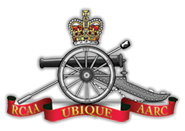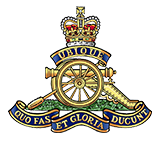Organization and Equipment 1945-68
The Reserve Force (renamed from Non-Permanent Active Militia) was also re-organized immediately after the Second World War into six divisional artilleries and corps troops. This provided for six divisional headquarters, RCA, eight medium regiments, 20 field regiments, eight anti-tank regiments, nine HAA Regiments, 18 LAA Regiments, five coast regiments, two survey regiments and nine AA gun operations rooms. This structure would last until 1954 when a reorganization of the Reserve Force resulted in the substantial reduction of the establishment of the artillery. In the aftermath anti-tank artillery ceased to exist, and the Militia artillery now consisted of 21 field regiments, six medium regiments, three independent medium batteries, nine HAA regiments, two harbour defence batteries, a locating regiment and an anti-aircraft fire control battery. It would be over 10 years before any other major changes were made to Militia artillery establishments.
In the Regular Force by the end of 1954, besides the four RCHA Regiments, the move to a divisional artillery organization resulted in the formation of a Divisional HQ RCA, the 1st LAA Regiment, the 1st Locating Battery and the No.1 Air OP Flight. In the anti-aircraft field, the missile systems then under development and the increasing speed of aircraft meant that the usefulness of the gun as an anti–aircraft weapon was going to diminish.
In the early fifties, each of the four Regular Force regiments was provided with a fourth battery armed with 4.2-inch mortars. In 1 RCHA this battery was designated Light Battery (Para), and later Z Battery. In the mid-fifties the RCHA regiments turned in their 25 Pdrs for the C1 105mm towed howitzer, and in 1958 replaced the 4.2-inch mortar in the light batteries with M1A1 155mm medium towed howitzers. The Militia regiments would eventually replace their 25 Pdrs with the new 105mm howitzers as they became available. In 1968, 1 RCHA in Germany, replaced its towed guns with self-propelled M109A1 155mm howitzers.
The 1st Light Anti-Aircraft Regiment RCA had been formed in October 1953. It consisted of a HQ and the 2nd and 3rd LAA Batteries located with the RCSA (Anti-Aircraft) at Picton, Ontario. The remaining battery, the 4th LAA Battery was at Esquimalt. The Regiment was originally equipped with 40mm Bofors, but converted to 90mm guns and M33C fire-control equipment in 1955. The 4th LAA Battery in Esquimalt was reduced to nil strength in 1957. The remainder of the regiment continued to function for three more years during which it helped to train anti-aircraft Gunners of the Militia.
Changes in defence policy resulted in the 1st LAA Regiment being disbanded in September 1960. The majority of its personnel went on to form two new units – the 1st and 2nd Surface-to- Surface Missile (SSM) Batteries RCA – at Hemer, Germany (with 4 CIBG) and Shilo respectively. Each battery was equipped with four 762mm Honest John Rocket launchers. The Honest John was a nuclear tactical weapon capable of carrying a 1-Kiloton nuclear warhead to a range of 40 km. Thus, was born the nuclear role of The RCA. The role of the 2nd SSM Battery was to train replacements and reinforcements for the 1st Battery. The SSM Batteries would remain in service until 1970, when the Canadian NATO Brigade Group’s role in Europe was reduced in scope.
Formation of the 1st Divisional Locating Battery in 1954 at Shilo marked the reappearance of a locating unit in the Order of Battle of the Regular Force after an absence of nine years. After a short, but fruitful existence, during which it played an active role in numerous exercises, the Battery fell victim to a general reorganization of close support artillery. Among other changes, locating units were decentralized to the Brigade Group level, and each RCHA regiment in Canada was given a Regimental Locating Battery as part of a new “5-battery organization.” The 1st Divisional Locating Battery was reduced to nil strength on 30 April 1958. It was revived briefly in 1965, and its Radar Troop equipped with the new AN/MPQ/501 Counter Mortar Radar. At the same time the RCHA and Militia locating batteries disappeared. The revived battery was located at Winnipeg, where it conducted drone and sound ranging trials with the National Research Council. Once the trials ended in 1968, the battery was once again reduced to nil strength.
Completing the order of battle of the 1st Divisional Artillery at the time of its formation in 1953 was Canada’s first peacetime Air OP Flight. No. 1 Air OP Flight was formed at Petawawa in 1953, followed by No. 2 Air OP Flight in Shilo in 1954. The flights were initially equipped with the British wartime Auster Mark VI aircraft, and in late 1954 were re-equipped with the US-built Cessna L-19. A number of field artillery officers underwent basic pilot training at the Brandon Flying Club. They then progressed to the Light Aircraft School at Rivers, Manitoba for advanced training. Their role was to provide aerial artillery observation, air photography, liaison and reconnaissance. In 1960, Air Observation Troops were added to the four RCHA regiments (Gagetown, Petawawa, Shilo and Fort Prince of Wales, Germany), and the two original Flights were reduced to nil strength. The new Air OP Troops operated under regimental control until 1970-71, when they converted to Kiowa helicopters and were subsequently absorbed into the Air Command helicopter squadrons.
On 1 February 1968, Canada’s three services ceased to exist as separate entities. Integration brought about the amalgamation of these services to form what is now called the Canadian Armed Forces. With that change came a severe reduction in the establishments of the Militia. Many Reserve Force artillery units were either converted to field Regiments, independent batteries, struck off the order of battle or converted to other arms.


